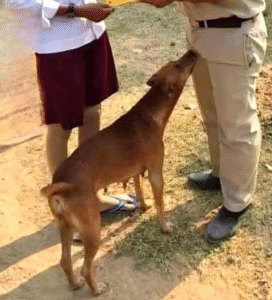🧠 The Science Behind the Sniff
Dogs possess up to 300 million olfactory receptors, compared to a human’s mere 6 million. Their brains are wired for scent: the part dedicated to smell is about 40 times larger than ours proportionally. This superpower allows them to detect everything from drugs and diseases to emotional states and hormonal changes.
🔍 Why the Genital Area?
Humans have apocrine glands concentrated in the armpits and genital region. These glands release pheromones—chemical signals that convey information about:
- Sex and reproductive status
- Emotional state
- Health conditions
- Recent sexual activity or menstruation
To a dog, sniffing this area is like reading a detailed biography. It’s not about curiosity alone—it’s about gathering data.
🐾 What Your Dog Might Be Learning
Here’s what your dog could be detecting when it sniffs your genital area:
- Hormonal shifts: Dogs can sense changes related to menstruation, pregnancy, or ovulation.
- Emotional cues: Stress, anxiety, or excitement alters your body chemistry, which dogs can pick up on.
- Health indicators: Some dogs are trained to detect cancer, diabetes, or infections through scent.
- Familiarity and bonding: Dogs use scent to recognize and bond with their humans.
In essence, your dog is saying, “I want to know how you’re doing.”
🐕 Social Norms in Dog Culture
In the canine world, sniffing the rear or genital area is a standard greeting. It’s how dogs say hello, establish hierarchy, and assess reproductive status. When they apply this behavior to humans, it’s not a breach of etiquette—it’s a translation of their social norms.
🧭 Instinct vs. Training
While instinct drives this behavior, dogs can be trained to redirect their sniffing habits. If your dog’s nose dives into a guest’s crotch, it’s not trying to embarrass you—it’s just doing what dogs do. But with gentle correction and positive reinforcement, you can teach them boundaries.
🧬 The Role of Jacobson’s Organ
Dogs have a specialized scent-processing system called the vomeronasal organ (or Jacobson’s organ), located above the roof of the mouth. This organ is designed to detect pheromones and plays a key role in interpreting social and sexual cues. It’s like a second nose, tuned specifically to the language of scent.
🧘 Emotional Resonance and Comfort
Some dogs sniff their owners more intensely when they’re feeling anxious or unwell. It’s a form of emotional attunement. Your dog may be seeking reassurance or offering comfort through closeness and scent recognition.
🧩 Cultural Perception vs. Animal Behavior
Humans often interpret this behavior as awkward or inappropriate. But dogs don’t share our cultural taboos. They operate in a world of scent, not shame. Understanding this helps us respond with compassion rather than embarrassment.
🌿 What You Can Do
If your dog’s sniffing feels intrusive, here are a few gentle strategies:
- Redirect attention: Offer a toy or treat to shift focus.
- Use commands: Reinforce boundaries with cues like “sit” or “leave it.”
- Socialize mindfully: Prepare guests for possible sniffing and explain the behavior.
- Consult a trainer: If the behavior becomes persistent or disruptive.
🧡 A Deeper Bond
Ultimately, your dog’s sniffing is a form of connection. It’s gathering information, expressing curiosity, and deepening its understanding of you. While it may feel awkward, it’s also a testament to the intimacy and trust between you.
So next time your dog sniffs your genital area, remember: it’s not judgment—it’s biology. And in that moment, your dog is simply saying, “I know you. I care.”


